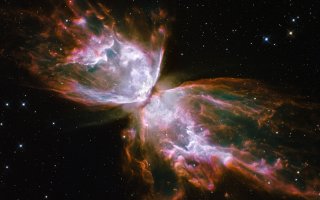The Hubble Space Telescope Is Turning 30. It Changed Everything.
It indeed has been an incredible ride over the last three decades, as Hubble has transformed astronomers’ understanding of the vast cosmos and gave us regular folks images that showcased the wonder and beauty that pervade our universe.
Later this month, NASA’s iconic Hubble Space Telescope will celebrate 30 years in space.
It indeed has been an incredible ride over the last three decades, as Hubble has transformed astronomers’ understanding of the vast cosmos and gave us regular folks images that showcased the wonder and beauty that pervade our universe.
The solar-powered Hubble launched into Earth’s orbit (now 340 miles above our planet) aboard the space shuttle Discovery on April 24, 1990, and the telescope was deployed a day later. Initial estimates pointed toward the school-bus-sized telescope being operational for about 15 years, and now, we know that it has turned into a great investment as it has doubled that expected lifespan.
In less than a year, the James Webb Space Telescope (Webb for short) will be launched into space and take much of the spotlight away from Hubble. The $10 billion space telescope, a joint venture between NASA, the European Space Agency, the Canadian Space Agency and Space Telescope Science Institute, is the much-vaunted successor to Hubble.
Being 30 years younger than Hubble, the massive telescope is equipped with much more advanced tools and sensors, such as a near-infrared camera and spectrograph, that will enable it to glean more comprehensive data regarding our own solar system, exoplanets, galaxies and the origins of the universe.
Webb’s future discoveries will surely be amazing, but let’s not forget about what Hubble was able to accomplish.
For example, in the late 1990s, Hubble’s observations proved that the universe’s expansion is indeed accelerating, a surprising find that propelled astrophysicists to hypothesize the existence of dark energy. This mysterious repulsive force causes the universe to expand faster and faster as time goes by.
Images taken by Hubble, which is equipped with a mirror that can collect about 40,000 times more light than the human eye, have also helped scientists estimate the size and age of the universe. Scientists now believe the universe is about 13.7 billion years old. An image called the “Hubble Ultra Deep Field” gave us a glimpse of the farthest known galaxies, and such related data has helped scientists understand how planets and galaxies initially form.
Furthermore, among more than 1 million observations, Hubble has detected black holes, studied atmospheres of exoplanets and revealed details of gamma-ray bursts, which are immensely powerful explosions of energy that occur when massive stars collapse. And who can forget the mind-blowing Eagle Nebula’s Pillars of Creation?
Hubble is expected to be functional for about five more years, and its orbit will be stable until the 2030s. Once the orbit begins to decay, the telescope will be deliberately crashed into Earth’s atmosphere, where it will likely burn up before it reaches the ground.
Ethen Kim Lieser is a Tech Editor who has held posts at Google, The Korea Herald, Lincoln Journal Star, AsianWeek and Arirang TV.

